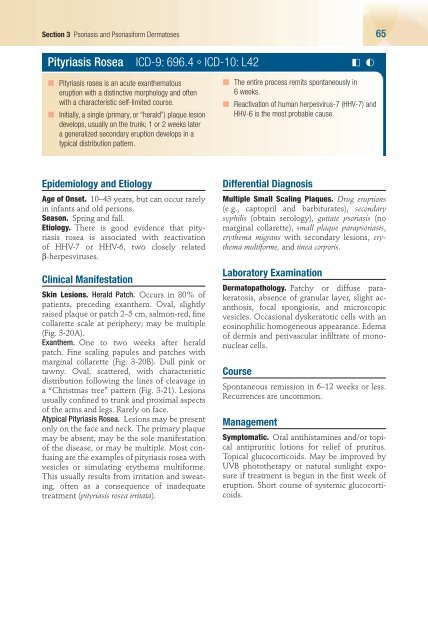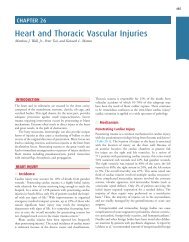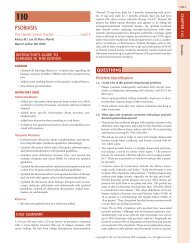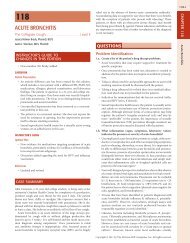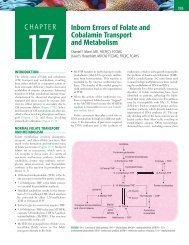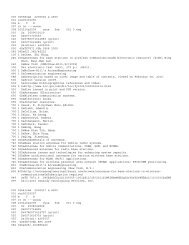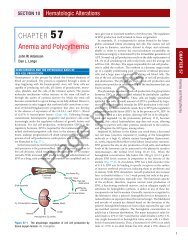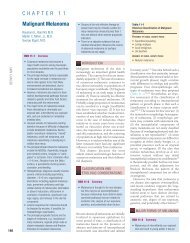TOC and Sample Chapters - McGraw-Hill Professional
TOC and Sample Chapters - McGraw-Hill Professional
TOC and Sample Chapters - McGraw-Hill Professional
Create successful ePaper yourself
Turn your PDF publications into a flip-book with our unique Google optimized e-Paper software.
Section 3 Psoriasis <strong>and</strong> Psoriasiform Dermatoses 65<br />
Pityriasis Rosea ICD-9: 696.4 ° ICD-10: L42<br />
■ Pityriasis rosea is an acute exanthematous<br />
eruption with a distinctive morphology <strong>and</strong> often<br />
with a characteristic self-limited course.<br />
■ Initially, a single (primary, or “herald”) plaque lesion<br />
develops, usually on the trunk; 1 or 2 weeks later<br />
a generalized secondary eruption develops in a<br />
typical distribution pattern.<br />
Epidemiology <strong>and</strong> Etiology<br />
Age of Onset. 10–43 years, but can occur rarely<br />
in infants <strong>and</strong> old persons.<br />
Season. Spring <strong>and</strong> fall.<br />
Etiology. There is good evidence that pityriasis<br />
rosea is associated with reactivation<br />
of HHV-7 or HHV-6, two closely related<br />
β-herpesviruses.<br />
Clinical Manifestation<br />
Skin Lesions. Herald Patch. Occurs in 80% of<br />
patients, preceding exanthem. Oval, slightly<br />
raised plaque or patch 2–5 cm, salmon-red, fine<br />
collarette scale at periphery; may be multiple<br />
(Fig. 3-20A).<br />
exanthem. One to two weeks after herald<br />
patch. Fine scaling papules <strong>and</strong> patches with<br />
marginal collarette (Fig. 3-20B). Dull pink or<br />
tawny. Oval, scattered, with characteristic<br />
distribution following the lines of cleavage in<br />
a “Christmas tree” pattern (Fig. 3-21). Lesions<br />
usually confined to trunk <strong>and</strong> proximal aspects<br />
of the arms <strong>and</strong> legs. Rarely on face.<br />
Atypical Pityriasis Rosea. Lesions may be present<br />
only on the face <strong>and</strong> neck. The primary plaque<br />
may be absent, may be the sole manifestation<br />
of the disease, or may be multiple. Most confusing<br />
are the examples of pityriasis rosea with<br />
vesicles or simulating erythema multiforme.<br />
This usually results from irritation <strong>and</strong> sweating,<br />
often as a consequence of inadequate<br />
treatment (pityriasis rosea irritata).<br />
■ The entire process remits spontaneously in<br />
6 weeks.<br />
■ Reactivation of human herpesvirus-7 (HHV-7) <strong>and</strong><br />
HHV-6 is the most probable cause.<br />
Differential Diagnosis<br />
Multiple Small Scaling Plaques. Drug eruptions<br />
(e.g., captopril <strong>and</strong> barbiturates), secondary<br />
syphilis (obtain serology), guttate psoriasis (no<br />
marginal collarette), small plaque parapsoriasis,<br />
erythema migrans with secondary lesions, erythema<br />
multiforme, <strong>and</strong> tinea corporis.<br />
Laboratory Examination<br />
Dermatopathology. Patchy or diffuse parakeratosis,<br />
absence of granular layer, slight acanthosis,<br />
focal spongiosis, <strong>and</strong> microscopic<br />
vesicles. Occasional dyskeratotic cells with an<br />
eosinophilic homogeneous appearance. Edema<br />
of dermis <strong>and</strong> perivascular infiltrate of mononuclear<br />
cells.<br />
Course<br />
Spontaneous remission in 6–12 weeks or less.<br />
Recurrences are uncommon.<br />
Management<br />
◧ ◐<br />
Symptomatic. Oral antihistamines <strong>and</strong>/or topical<br />
antipruritic lotions for relief of pruritus.<br />
Topical glucocorticoids. May be improved by<br />
UVB phototherapy or natural sunlight exposure<br />
if treatment is begun in the first week of<br />
eruption. Short course of systemic glucocorticoids.


